Bowers & Wilkins Zeppelin iPod Speaker Dock Review
Bowers & Wilkins Zeppelin iPod Speaker Dock
The best iPod speaker dock available - simple as that.
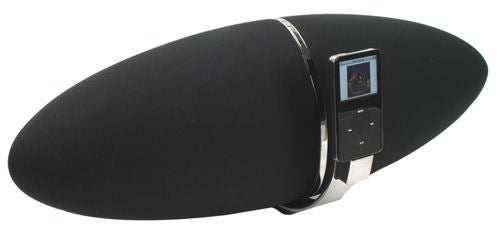
Verdict
Key Specifications
- Review Price: £399.00
Buying your first hi-fi is like a rite of passage. The point at which you realise that those all-in-one stereo systems with all the flashing lights have nothing to do with sound quality and everything to do with shop floor attraction is like an epiphany – sadly it’s an epiphany that many never experience. After experiencing my moment of clarity, as Jules would put it, in my late teens, I went shopping for my first hi-fi separates, along with my first set of “proper” loudspeakers. The speakers I settled on were a set of B&W DM 560s, and they were absolutely beautiful. In fact I was so impressed with my first set of B&W speakers, that I have never bought speakers from a different manufacturer ever since!
Unfortunately for high fidelity companies like B&W, the audio trend has swung away from quality and towards convenience over the past few years, and now the majority of consumers are listening to compressed music on devices like Apple’s iPod. As a result of this transition, many companies have tried to mesh high end audio equipment with the iPod – the Fatman iTube ValveDock instantly springs to mind. And now B&W has decided to embrace the iPod generation with the launch of its Zeppelin iPod speaker dock.
Gordon first reported on the Zeppelin back in August 2007, and I tried to get hold of a review sample back then, but B&W had decided to only launch it in the US, which was odd, considering it’s a UK company. Anyway the Zeppelin is finally hitting UK shores, and for anyone who’s wondering – yes, it was well worth waiting for!
B&W may be all about sound quality, but it clearly knows a thing or two about design aesthetics too. The company’s Nautilus speakers remain one of the most beautiful design statements in the audio world, assuming that you have a large enough room to accommodate them and £44,000 burning a hole in your pocket. The Zeppelin may not be as imposing a design statement as the Nautilus speakers, but it is very beautiful. Now, beautiful is not a word that I use to describe products very often, but I really can’t think of any other way to describe the Zeppelin. Put simply, even if you never switch the Zeppelin on, it will still give you much pleasure every time you look at it.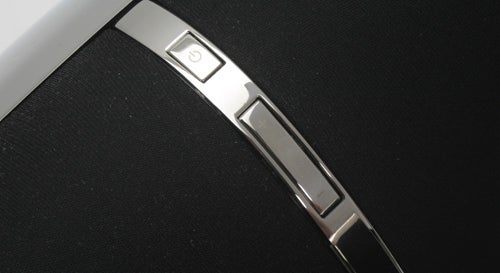
One look at the Zeppelin will tell you why B&W gave it its moniker – it looks pretty much just like a Zeppelin, although with considerably less chance of bursting into flames and killing every passenger on board. The ellipsoid styling gives the Zeppelin a decidedly organic look, much like the aforementioned Nautilus speakers. The black speaker covering is offset by the chrome band the wraps around the very centre of the device. With dimensions of 640 x 208 x 173 (WxDxH), the Zeppelin demands enough room to be appreciated, unlike many iPod speaker docks which find homes on bedside tables instead of clock radios.
One of the design highlights (and believe me, there are many) is the actual iPod dock, which makes every single implementation I’ve seen before look clumsy. Projecting from the base of the Zeppelin is a solid metal band that follows the curve of the speaker casing. Just below the mid point, you’ll find the iPod connector mounted in a chrome block bearing the B&W logo. Unlike every other iPod speaker dock I’ve encountered, the Zeppelin doesn’t employ an endless array of adapters to accommodate all the different form factors of iPod – the dock on the Zeppelin fits each and every type of iPod without the need for annoying bits of plastic.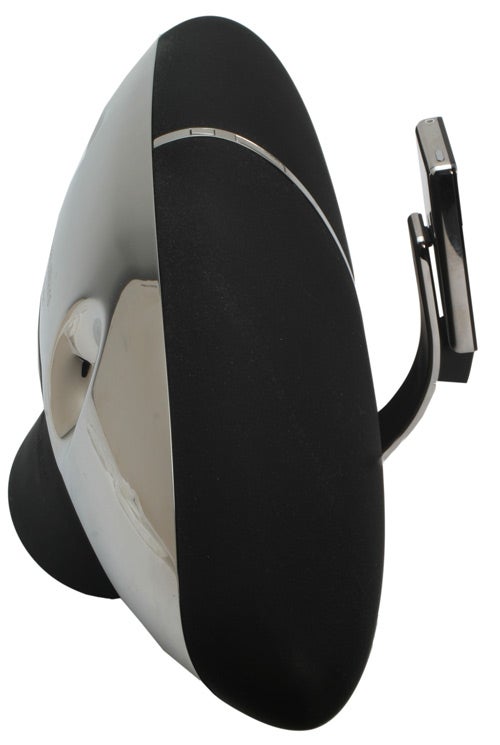
The key to the Zeppelin’s universal iPod support is the spring loaded connector. When you connect an iPod a spring pushes the device against the metal band behind it – this means that regardless of the size, shape or thickness of your iPod, it will always rest securely against the metal backing plate, ensuring that no strain is ever put on the docking connector in either the Zeppelin or your iPod. This design also allows for easy navigation of the iPod while it’s docked, again putting no pressure on the connector, since your fingers naturally wrap around the metal support band, rather than the back of the iPod as with other docks.
Unbelievable as it may sound, but the back of the Zeppelin looks almost as good as the front. The rear is finished in mirrored chrome, with twin bass ports mounted at equal distance from the centre – the effect is quite stunning, which is saying something considering you’ll rarely see the back of the unit except when connecting it up!
Talking of connecting up, there’s a pretty generous array of connections to complement the iPod dock. There’s an auxiliary input for hooking up a non-iPod source device – this is a standard 3.5mm mini-jack affair, but it’s worth mentioning that it will accept an optical digital input as well as an analogue one. You also get S-Video and composite video outputs for streaming video from your iPod to your TV. An interesting connector is a USB port, which at first I thought was there to sync an iPod, but in fact it’s there for updating the firmware in the Zeppelin, which is a pretty compelling USP in itself.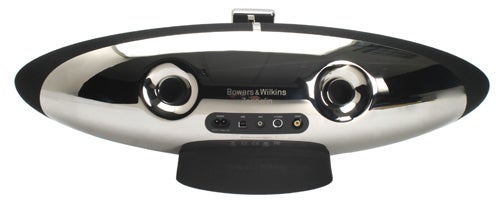
But it’s inside the Zeppelin that B&W has worked its magic with the driver configuration – whereas most iPod docks just use off the shelf speakers that fit a cabinet design, B&W has designed drivers specifically for the Zeppelin in order to create a balanced and cohesive sound. At the far edges of the tapered cabinet are the left and right tweeters and adjacent to these you’ll find midrange drivers. Dead centre is the large bass driver – this is where most speaker docks fall down, they either lack bass response, or it sounds forced and overpowering. But when you remember that B&W is a high-end speaker manufacturer, it’s clear that the drivers will not be an issue and there will be none of the separated sound problems that plague low-quality speaker docks that employ poor crossover technology.
Of course the really important thing is sound quality and I have to say that you simply won’t believe that an iPod could sound this good. I’ve heard countless iPod speaker docks, but the Zeppelin doesn’t just take things to another level, it moves them to another dimension! OK, so any audiophiles out there will argue that any all-in-one device that’s designed to playback compressed music from a portable player will compromise musical fidelity, and they’d be right, but they’d also be missing a very important point. Like it or not, the majority of consumers out there listen to most of their music as compressed digital files, and a large percentage do that via an iPod. So, once you’ve accepted that you’re working with a device with intrinsic audio limitations, the key is to produce the best possible experience using said device, and that’s exactly what B&W has done.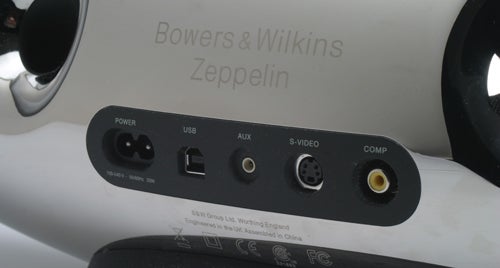
The sound from the Zeppelin is just so beautifully balanced that it’s sometimes hard to believe that it’s coming from an iPod speaker dock and not a hi-fi. B&W’s legendary reputation in the loudspeaker market comes shining through, allowing the Zeppelin to turn its hand to any genre of music with equally stunning results. Listening to Paul McCartney’s superb Band on the Run, helped me to remember that this is a man who should be in the media for his groundbreaking music, not for his messy divorce. This is a track with more subtle nuances than you can shake a stick at and the Zeppelin revelled in the challenge and produced an encore worthy performance. No matter how many times the music changed tack, it didn’t phase the Zeppelin – the light guitar riffs and the vocals were given a beautifully melodic presence, while the underlying bass line kept the sound full and flavoursome.
Turning to another musical legend I fired up 50 Ways To Leave Your Lover by Paul Simon, another track that’s etched into my brain not from years, but from decades of listening. That snare drum intro sets the tone for the whole song and continues throughout the proceedings – not only does the Zeppelin do an amazing job of rendering this distinctive percussion arrangement, but it also manages keep it easily discernable throughout the entire song. Meanwhile the simple guitar chords that sit just behind the vocals add just the right amount of atmosphere without becoming distracting. Finally, the backing singers during the chorus are clearly heard and complement Paul’s lead vocals perfectly – something that’s often lost in the mix when listening on poor speakers.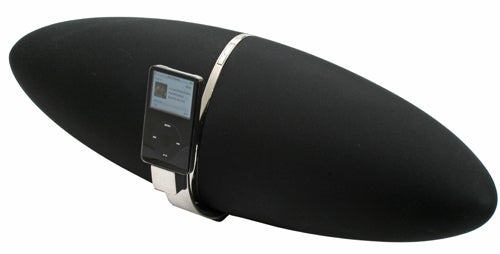
Just to prove that my entire music collection isn’t made up of artists called Paul, I thought I’d move onto Aimee Mann and her haunting rendition One. Aimee’s take on One is a major departure from the Three Dog Night original, but I find that the best covers often are. Once again the Zeppelin did a fabulous job of capturing not just the sound, but the atmosphere of the song, with the near desperation in Aimee’s vocals coming through loud and clear. But the Zeppelin still managed to project the subtle background percussion, with the gentle tap of a high hat as easily discernable as the bass drum.
Ultimately, the Zeppelin is just as comfortable with Aimee Mann’s subtle and angelic vocals, as it is with Dave Grohl’s more urgent screams and yells. Even throwing some Claude Debussy at the Zeppelin just reaffirmed its talents, with Clair de Lune just flowing forth like honey. Likewise, The Girl with the Flaxen Hair sounds truly beautiful via the Zeppelin – quite an achievement for any hi-fi, let alone an iPod dock.
The aforementioned S-Video and composite video connections on the rear allow you to pass through iPod video to a TV, but why anyone would want to do that is beyond me. Most iPod video is of questionable quality at best, and plain awful the rest of the time. You can get away with low resolution, low bit rate video on a tiny iPod screen, but once you blow it up on a large screen TV, it just looks horrible. If you are planning on piping video from your iPod through to a TV, I can tell you that a fifth generation iPod had no problems outputting video, but both the iPod touch and iPhone refused to play video on anything other than the internal screen. B&W are aware of this limitation and are working on a fix, but I feel that anyone who’s concerned enough with sound quality to want a device like the Zeppelin, is unlikely to ever want to watch iPod video on their TV.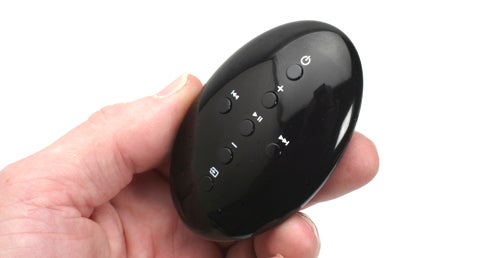
The infrared remote control is small and simlarly shaped to the Zeppelin itself. Although some who tried it found it a little small to hold comfortably, I had no issue with it. That said, the buttons are somewhat small, and some backlighting would have been a nice touch for anyone who likes to listen to music with the lights dimmed.
B&W doesn’t make cheap products, so it comes as no surprise that the Zeppelin is the most expensive iPod speaker dock to ever feature on TrustedReviews. However, I still feel that the Zeppelin offers incredible value for money, since value is measured by what you’re getting for your money not how cheap something is to purchase. So, while many of you will feel that £400 is a ludicrous amount of money to spend on an iPod dock, you need to put that price into context.
First and foremost, the Zeppelin sounds better than the vast majority of consumer targeted hi-fi systems. Secondly, if you wanted a hi-fi that sounds better than this, you’d be spending a hell of a lot more than £400. Thirdly, for anyone who keeps all their music on an iPod, the Zeppelin will provide you with a truly staggering listening experience. 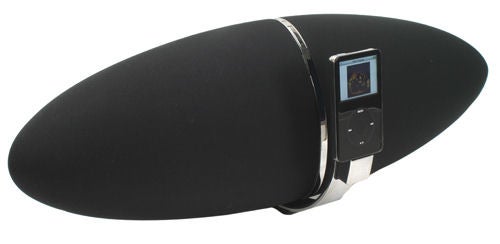
There is a caveat though, as with high-end earphones like Shure’s E500s, you need high quality encodes to get the best out of the Zeppelin. So, if you’re happy to rip your music at 128kbps MP3, you really won’t be getting the best out of the Zeppelin. But if you’re concerned enough with sound quality to rip at 320kbps MP3, or even better, rip using a lossless codec, the Zeppelin is definitely for you. In fact, even though the majority of my music is encoded using a high bit rate, I’m seriously considering ripping my entire CD collection all over again using a lossless codec, just so I can get the best out of high-end digital audio products like the Zeppelin.
”’Verdict”’
Rather than shy away from the digital music revolution, B&W has embraced it and created a product that brings hi-fi sound to the iPod generation. Despite the intrinsic limitations of compressed digital music, B&W has managed to produce an iPod speaker dock that raises the bar so high, I doubt that the competition can see it, let alone reach it. The Zeppelin sounds staggeringly good no matter what genre of music you throw at it, and any iPod users who are serious about their music should start saving now.
Trusted Score
Score in detail
-
Value 8
-
Features 9
-
Design 10

